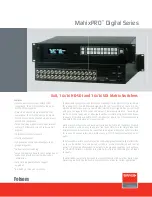
Data Sheet
© 2008 Cisco Systems, Inc. All rights reserved. This document is Cisco Public Information.
Page 2 of 5
The rich features of the WebView management software include Simple Network Management
Protocol (SNMP), Remote Monitoring (RMON), Telnet, and HTTP management options, allowing
you to flexibly integrate and manage these devices in your network.
Automatic load sensing in the power control circuitry automatically detects Power over Ethernet
(PoE) on the access points before providing power. Power feeding of Ethernet is limited for fixed
10BASE-T/100BASE-TX ports. The switch can provide maximum output power per PoE port up to
15.4W on 12 ports or 7.5W on 24 ports simultaneously. Each port has independent overload and
short-circuit protection, with LED indicators for power status. The switch also supports IEEE
802.3af MIB for PoE, IEEE 802.1d STP, IEEE 802.1w RSTP, Fast Linkover, and IEEE 802.1s
MSTP. Cable diagnostics can be performed using the switch’s WebView utility.
Features
●
Twenty-four 10/100 switched RJ-45 ports deliver up to 4 Gbps of throughput per port
●
Two shared 10/100/1000 mini Gigabit Interface Converter (mini-GBIC) ports
●
Switching capacity delivers wire-speed performance at 12.8 Gbps, nonblocking capacity
●
WebView monitoring allows administrators to view the current status and configuration
using their favorite web browser
●
PoE on twenty-four 10/100 ports supplies up to 7.5W per port, or on twelve 10/100 ports
supplies up to the IEEE 802.3af maximum of 15.4W per port
●
Automatic medium dependent interface (MDI) and MDI crossover (MDI-X) cable detection
●
Port-based and 802.1Q-based VLANs support up to 256 VLANs
●
Port trunking for up to eight groups allows you to increase your bandwidth for each uplink or
server connection
●
Port configuration settings for link, speed, auto MDI/MDI-X, flow control, and more
●
Fully rack mountable using the included rack-mounting hardware
●
MAC address table supports up to 8000 MAC address entries
●
Optimal platform to support real-time applications such as voice and video, with features
like IGMP snooping, multiple queues (4) with appropriate scheduling techniques,
prioritization of traffic based on port, 802.1p, IP ToS/precedence/DSCP, TCP/ User
Datagram Protocol (UDP) port, and line rate forwarding mechanisms
●
Enhanced QoS functions including rate limiting for ingress/egress and per flow at 64 kbps
granularity
●
Secure control via SSH for Telnet interface and SSL for HTTP interface
●
User/network security via 802.1X (with RADIUS authentication) and MAC-based filtering
●
Advanced security ACL can deny or limit network access based on Layer 1 through Layer 4
information - for example, MAC address, Ethernet type, VLAN ID, IP address, protocol ID,
or TCP/UDP port
●
Containment of storms - broadcast and multicast
●
Expandability and availability increased across multiple switches using link aggregation
●
Port trunking for up to eight groups with up to eight ports per group, allowing you to
increase your bandwidth for each uplink or server connection
●
SNMP and RMON management expand your visibility options























